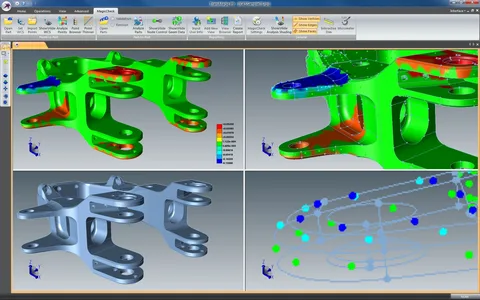Best CAD Software for 3D Printing Professionals

In the rapidly evolving world of 3D printing, having the right tools can make all the difference. For professionals who want to stay ahead, choosing the best CAD software is crucial. CAD software for 3D printing allows designers to create precise, complex models that can be easily converted into printable formats. Whether you are designing prototypes, functional parts, or artistic creations, the right software ensures efficiency, accuracy, and innovation.
With the growing demand for 3D printing in industries such as aerospace, automotive, healthcare, and consumer products, CAD software has become an indispensable asset. Modern solutions offer advanced features like parametric modeling, simulation, and real-time rendering, helping professionals bring their concepts to life. Selecting the right CAD software for 3D printing not only enhances productivity but also improves the quality and feasibility of the final printed objects.
Understanding CAD Software for 3D Printing
CAD software for 3D printing is designed to bridge the gap between digital design and physical production. Unlike traditional design tools, these software solutions focus on creating models that can be directly printed with 3D printers. They provide features such as mesh analysis, slicing preparation, and file format compatibility with STL, OBJ, or AMF files, which are essential for accurate 3D printing. Professionals rely on these tools to ensure that their designs are structurally sound and optimized for print.
Moreover, CAD software for 3D printing offers both parametric and direct modeling capabilities. Parametric modeling allows users to define relationships between different components, making it easier to adjust designs without starting from scratch. Direct modeling, on the other hand, provides more flexibility for artistic or complex shapes. Understanding these features and their applications is essential for 3D printing professionals who aim to create high-quality, reliable prints.
Top CAD Software Options for Professionals
Several CAD software options dominate the 3D printing market, each catering to different needs and skill levels. Autodesk Fusion 360, for instance, combines CAD, CAM, and CAE tools in one platform, making it ideal for both industrial and creative projects. It offers cloud-based collaboration, parametric modeling, and simulation tools, helping professionals iterate designs quickly. Fusion 360 also provides plugins for 3D printing, ensuring seamless preparation and export of models.
Another popular choice is SolidWorks, which is widely used in engineering and product design. SolidWorks excels in parametric modeling, complex assemblies, and mechanical simulations. Its built-in tools for 3D printing help professionals analyze geometry, detect errors, and optimize parts for printing. For designers focused on artistic or organic models, software like Rhino 3D or Blender offers powerful surface modeling and sculpting capabilities, making them indispensable tools in a professional’s toolkit.
Features to Look for in CAD Software for 3D Printing
When selecting CAD software for 3D printing, certain features are non-negotiable for professionals. First and foremost is file compatibility. The software should support standard 3D printing file formats such as STL, OBJ, and AMF to ensure smooth transfer between design and printer. Accurate mesh analysis is another critical feature, as it allows designers to detect and correct errors that could compromise print quality. Without these tools, even the most advanced design may fail during printing.
Simulation and optimization tools are equally important. Advanced CAD software provides stress analysis, thermal simulation, and motion studies to help professionals test designs virtually before printing. These features save time, reduce material waste, and increase the success rate of prints. Additionally, user-friendly interfaces and robust customer support play a crucial role in ensuring that designers can focus on creativity and precision rather than troubleshooting software issues.
Benefits of Using Professional CAD Software for 3D Printing
Investing in professional CAD software for 3D printing brings numerous benefits to designers and engineers alike. High-quality software enables precise modeling, allowing professionals to create complex geometries that are difficult or impossible to achieve manually. This precision is essential for industries like aerospace and medical devices, where accuracy can directly impact functionality and safety. Professional CAD tools also streamline workflows, from conceptual design to final print preparation, reducing the time it takes to bring an idea to reality.
Furthermore, these software solutions foster collaboration and innovation. Many professional CAD platforms offer cloud-based features, allowing teams to work simultaneously on the same project. Designers can share models, receive feedback, and make adjustments in real-time, accelerating the development process. By leveraging the power of CAD software for 3D printing, professionals can experiment with new concepts, optimize designs for performance, and ultimately create higher-quality products faster.
Future Trends in CAD Software for 3D Printing
The future of CAD software for 3D printing is closely tied to advancements in artificial intelligence, machine learning, and generative design. These technologies allow software to suggest optimal designs based on specific parameters, significantly reducing trial and error. Professionals can leverage AI-driven tools to create lightweight, strong, and cost-effective parts with minimal manual input. As 3D printing technology evolves, CAD software will continue to integrate more intelligent features, enhancing productivity and creativity.
Additionally, cloud-based and collaborative CAD platforms are gaining momentum, enabling remote teams to work seamlessly from different locations. This trend is reshaping the way professionals approach design and production, making it easier to share knowledge, manage projects, and iterate designs rapidly. With ongoing innovations, CAD software for 3D printing will remain a cornerstone for professionals seeking to push the boundaries of design and manufacturing.
In conclusion, choosing the best CAD software for 3D printing is critical for professionals aiming to excel in the rapidly growing additive manufacturing industry. With tools that offer precision, advanced simulation, and collaboration features, designers can transform ideas into reality with efficiency and accuracy. Whether you are a seasoned engineer or a creative designer, investing in the right CAD software ensures your 3D printing projects are successful, innovative, and future-ready.







